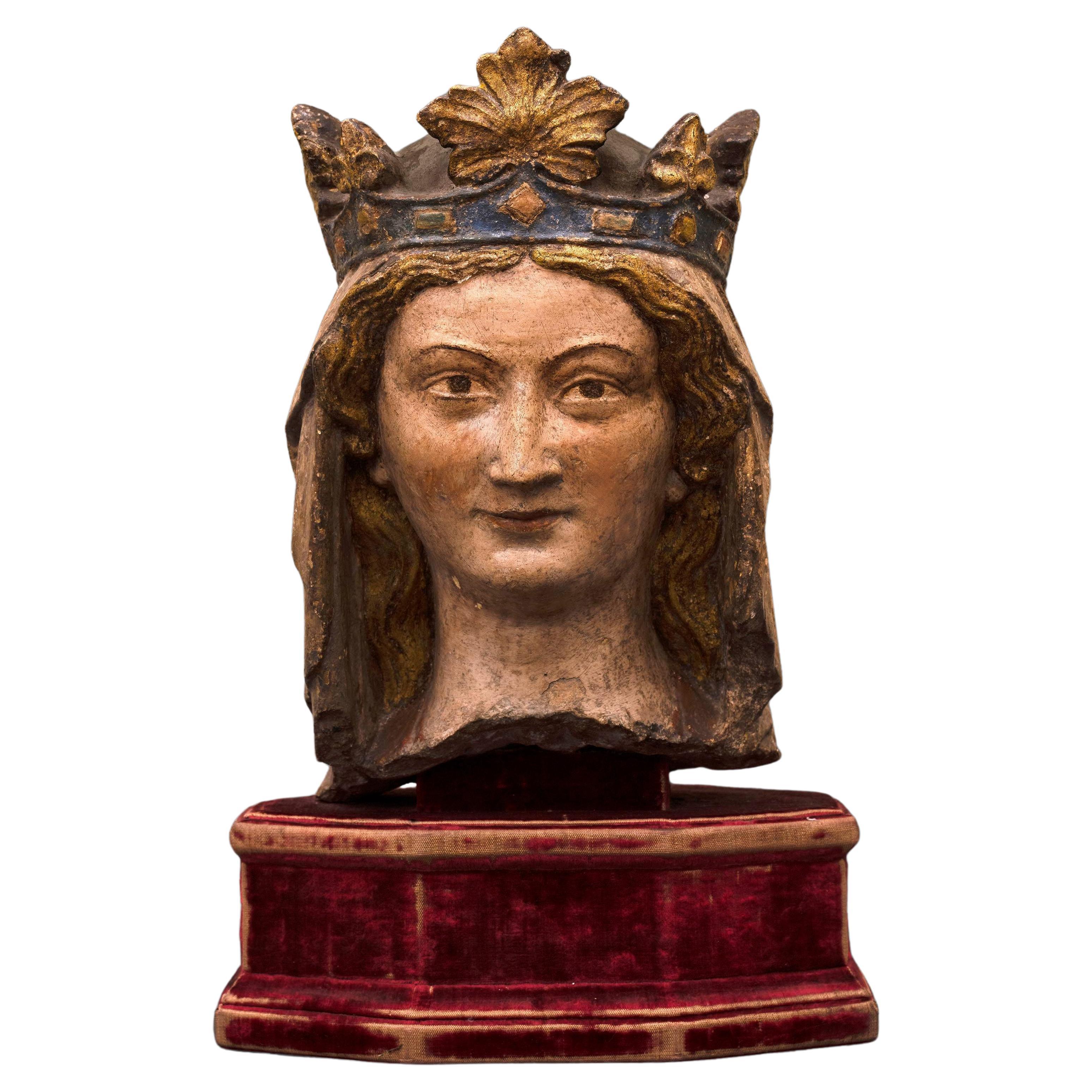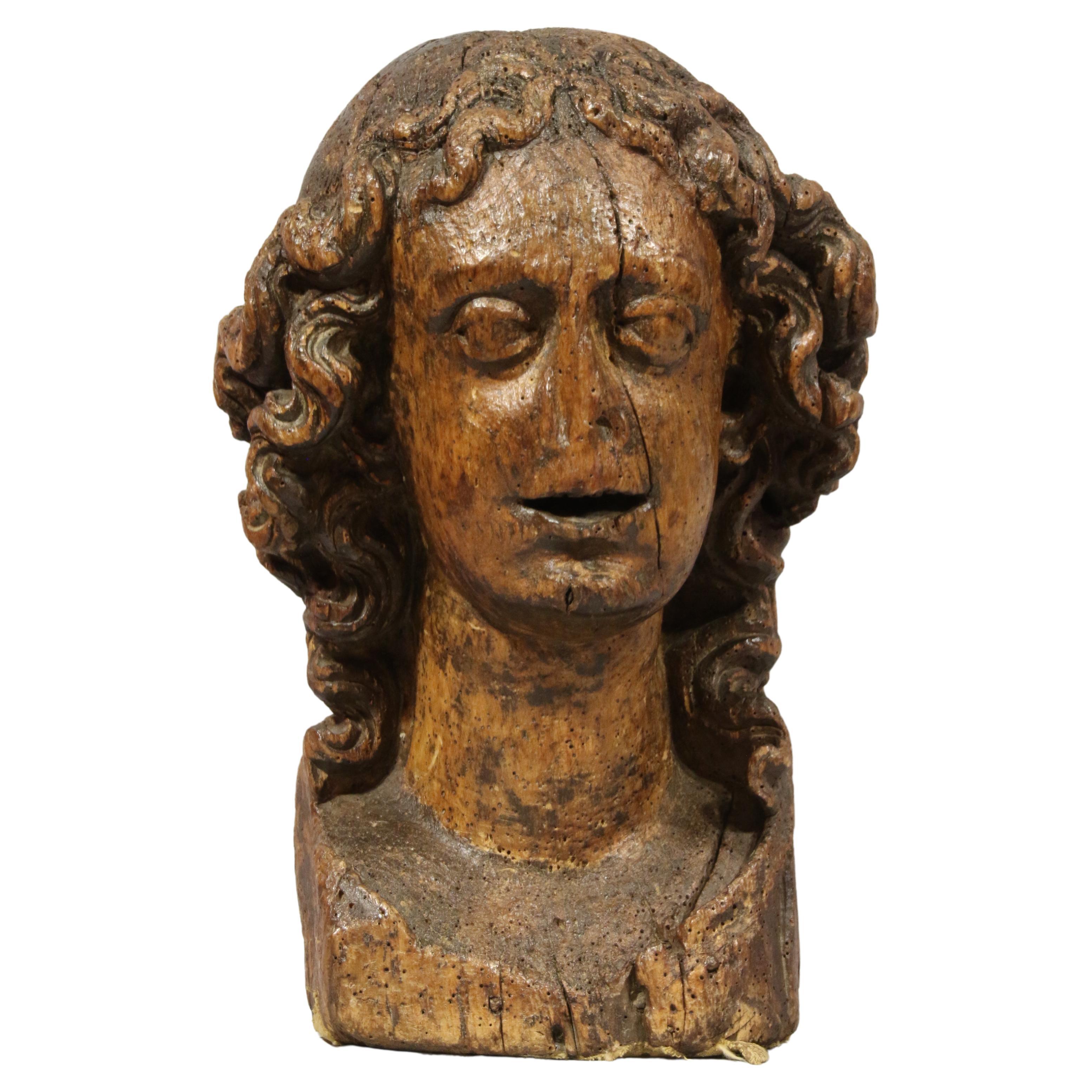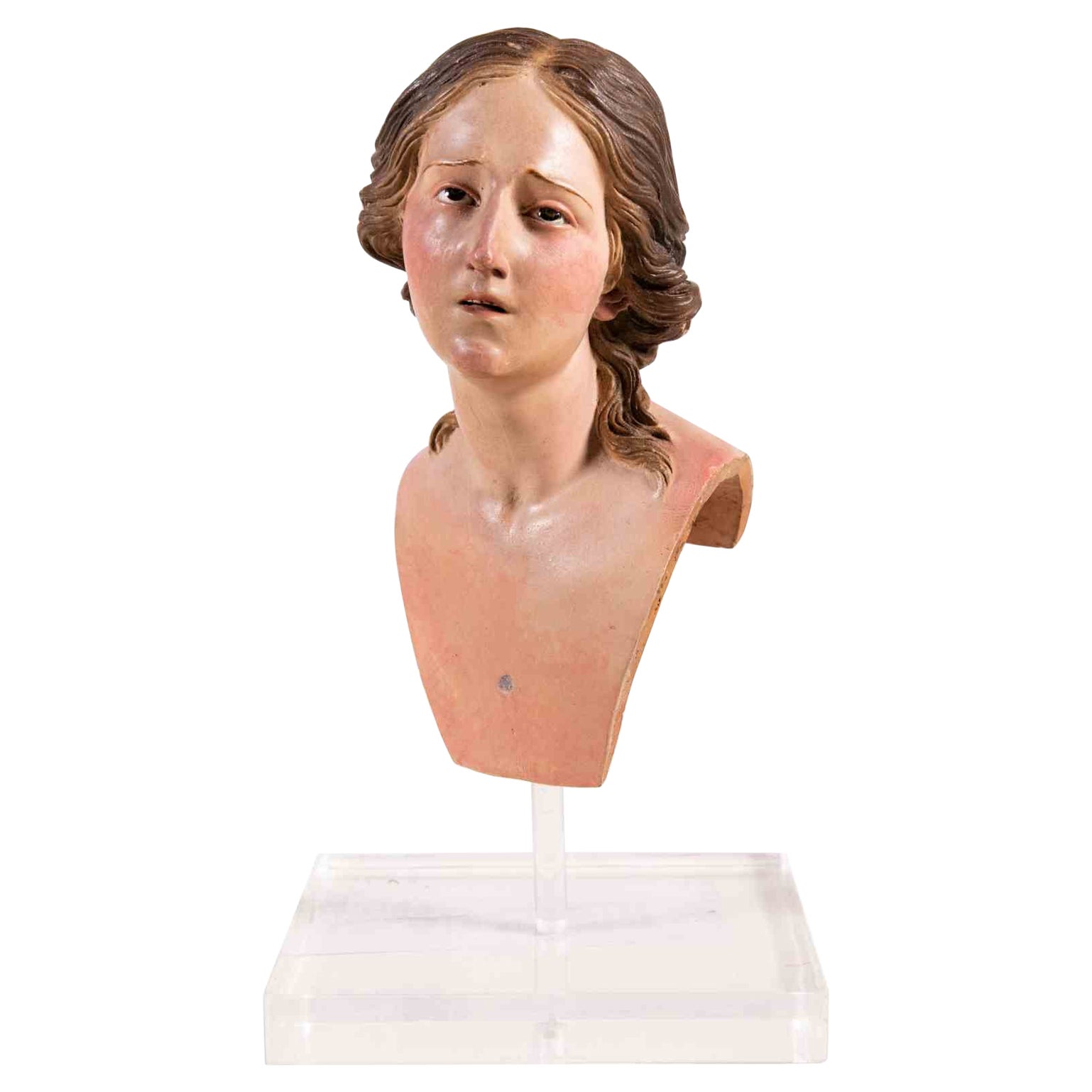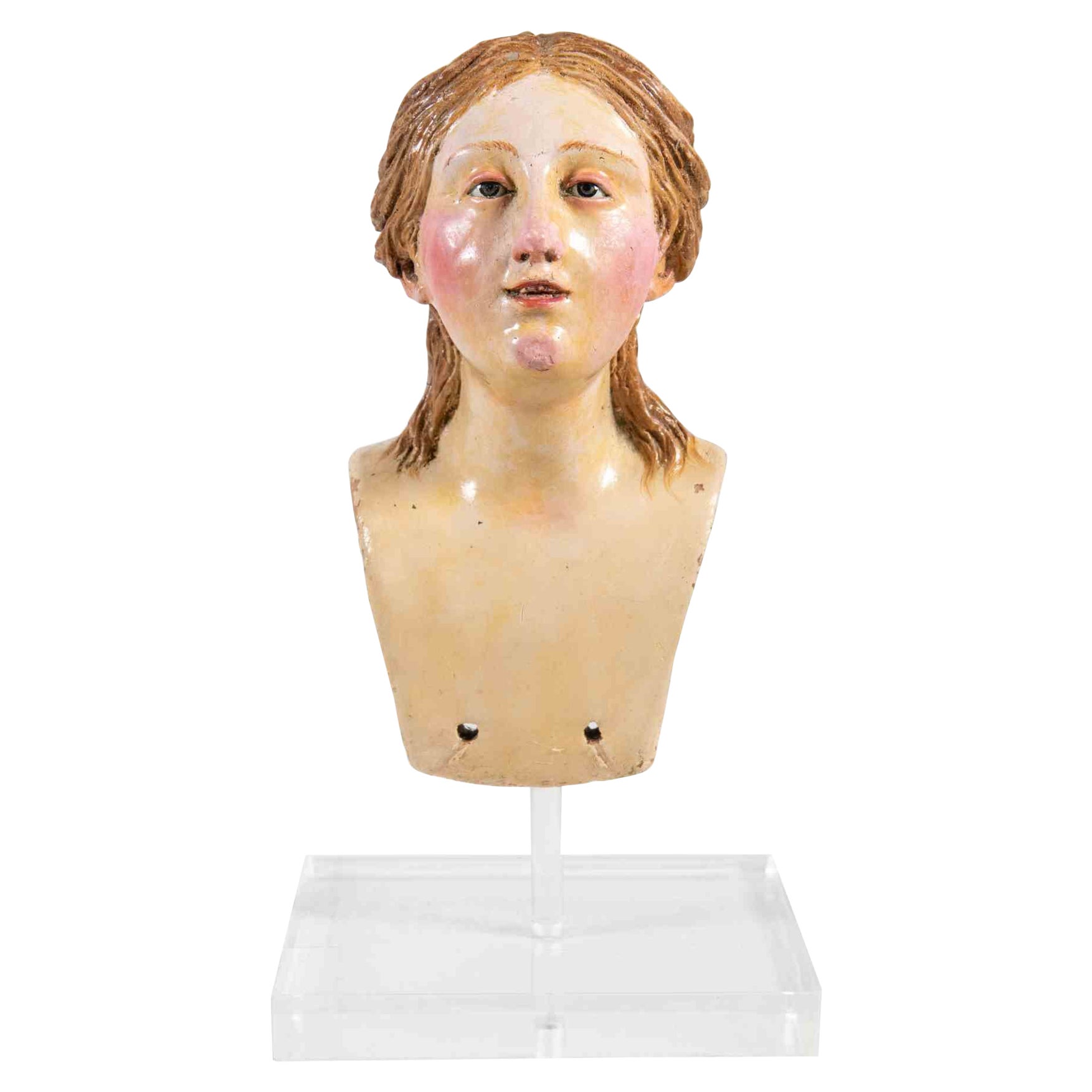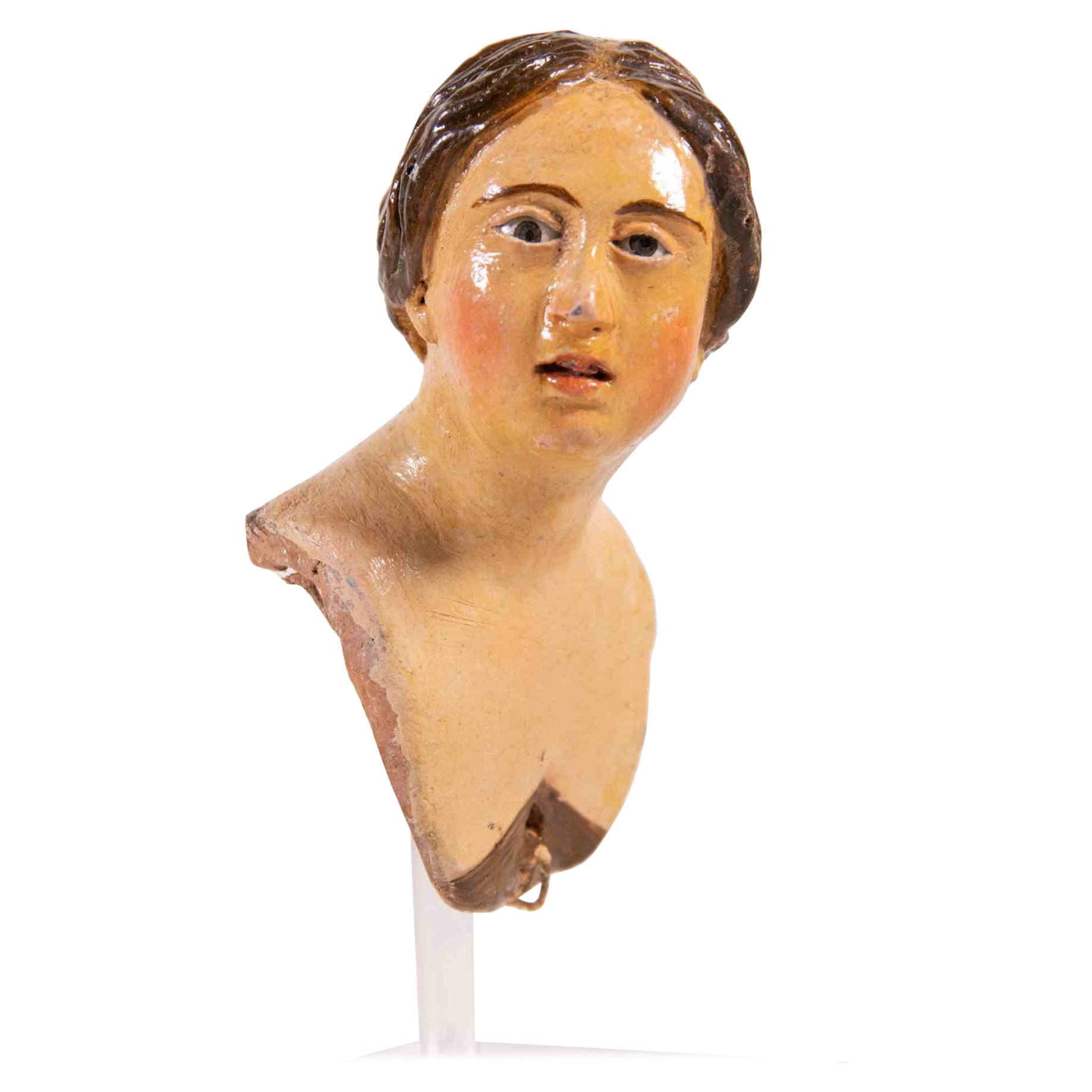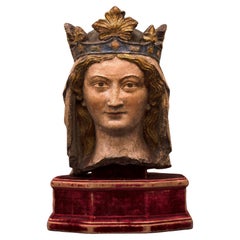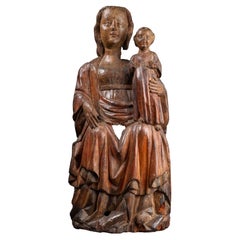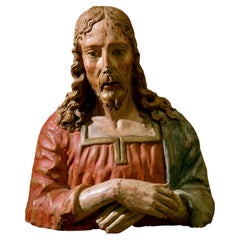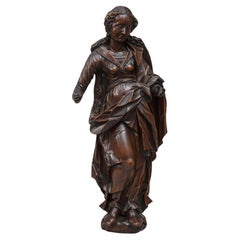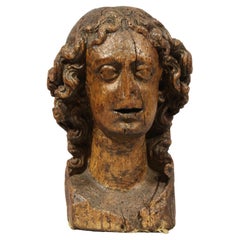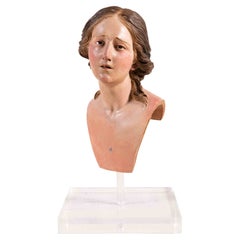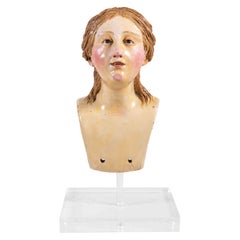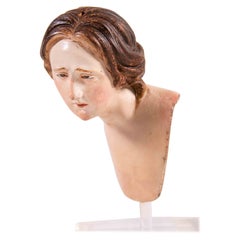Items Similar to Head of a crowned Virgin - Lorraine, first half of 14th century
Want more images or videos?
Request additional images or videos from the seller
1 of 6
Head of a crowned Virgin - Lorraine, first half of 14th century
$69,842.81
£51,674.95
€58,000
CA$96,570.11
A$106,021.94
CHF 55,311.87
MX$1,283,013.06
NOK 693,248.45
SEK 653,222.31
DKK 441,613.62
About the Item
Head of a crowned Virgin
Lorraine, first half of 14th century.
H26 x 14 x 14 cm
Provenance :
- Private Collection, Paris France (1960)
Private Collection Tuscany, Italy (1980)
Expertise by Art historian Bênoit Bertrand
The face is delicately shaped, with fine, refined features: almond-shaped eyes framed by gently defined upper eyelids, a long, straight nose, and a mouth with thin lips, the upper lip slightly protruding. The chin is small and rounded, and the neck is strong and muscular.
Slightly inclined, with her gaze directed downward to the right, the Virgin’s graceful head is crowned with a jewel-encrusted diadem, its fleurons set with precious stones. This crown rests atop a short veil, which partially covers her wavy hair. The angle of her head suggests that she is cradling the Child in her arms, gazing upon Him.
The exceptional quality of the sculptural execution, marked by finely detailed features, reveals an artist’s extraordinary skill and precision.
The characteristic "shield-shaped" face, framed by cascading wavy hair, and the almond-shaped eyes are hallmark traits of the Lorrain Virgins from the first half of the 14th century. Artists in northeastern France adapted the established style from Île-de-France, incorporating distinct regional elements, such as the short veil, the expressive, flattened face, the strong neck, and the pensive, solemn attitude.
This sculpture can be closely compared to a Virgin and Child from Lorraine, created during the same period, now preserved in the Metropolitan Museum of Art in New York.
A fragmentary Virgin’s head, displayed at the Louvre, although frontal in pose, shares unmistakable affinities with this one: both feature a crown adorned with cabochons and fleurons, supporting a short veil, its flattened pleats framing a head of wavy hair. The facial structure, slightly triangular, and the pronounced neck further align the two works.
What is particularly remarkable about this Virgin's head is the preservation of its original polychromy, with vibrant rosy tones on the cheeks and golden highlights in the hair, as well as the exceptional quality of the sculpting and the gentle, harmonious rendering of her features.
- Dimensions:Height: 10.24 in (26 cm)Width: 5.52 in (14 cm)Depth: 5.52 in (14 cm)
- Style:Gothic (Of the Period)
- Materials and Techniques:
- Place of Origin:
- Period:
- Date of Manufacture:14th century
- Condition:Refinished. Wear consistent with age and use. Very slight retouching to the polychromy.
- Seller Location:Bruxelles, BE
- Reference Number:1stDibs: LU6666242549832
About the Seller
5.0
Vetted Professional Seller
Every seller passes strict standards for authenticity and reliability
1stDibs seller since 2022
15 sales on 1stDibs
Typical response time: <1 hour
- ShippingRetrieving quote...Shipping from: Bruxelles, Belgium
- Return Policy
Authenticity Guarantee
In the unlikely event there’s an issue with an item’s authenticity, contact us within 1 year for a full refund. DetailsMoney-Back Guarantee
If your item is not as described, is damaged in transit, or does not arrive, contact us within 7 days for a full refund. Details24-Hour Cancellation
You have a 24-hour grace period in which to reconsider your purchase, with no questions asked.Vetted Professional Sellers
Our world-class sellers must adhere to strict standards for service and quality, maintaining the integrity of our listings.Price-Match Guarantee
If you find that a seller listed the same item for a lower price elsewhere, we’ll match it.Trusted Global Delivery
Our best-in-class carrier network provides specialized shipping options worldwide, including custom delivery.More From This Seller
View AllGothic crowned Head - Île de France, 14th century
Located in Bruxelles, BE
Head of a crowned Virgin
Île-de-France, first half of 14th century.
H26 x 14 x 14 cm
Provenance :
- Private Collection, Paris France (1960)
- Private Collection Tuscany, Italy (19...
Category
Antique 15th Century and Earlier French Gothic Figurative Sculptures
Materials
Stone
Virgin and the Child, Mosan Region, Second Half of 13th Century
Located in Bruxelles, BE
A polychrome sculpture depicting the Virgin and the Child
Mosan region, second half of 13th century
Polychrome wood
73 x 29 X 12 cm
Provenance :
Former Belgian private collection from the beginning of the 20th century
This remarkable early artwork portrays the Enthroned Virgin and Child, also known as Sedes Sapientiae, which translates to the 'Seat of Wisdom...
Category
Antique 15th Century and Earlier Belgian Medieval Figurative Sculptures
Materials
Wood
Terracotta Bust of Christ as the Redeemer, 15th Century
Located in Bruxelles, BE
A terracotta bust of Christ as The Redeemer
Tuscany or Emilia Romagna, late 15th century
Measures: 46 x 43 x 21 cm
This powerful, moving bust of...
Category
Antique 15th Century and Earlier Italian Renaissance Figurative Sculptures
Materials
Terracotta
Statuette of the Virgin, South German circa 1600
Located in Bruxelles, BE
Statuette of the Virgin
South-German, circa 1600
sculpted wood
circa 1600
(right arm restored)
52 cm
Category
Antique 17th Century German Renaissance Religious Items
Materials
Wood
Ecce Homo - Florence, 15th century
Located in Bruxelles, BE
A terracotta bust "Ecce Homo"
Florence, 15th century
53 x 44 x 31 cm
Category
Antique 15th Century and Earlier Italian Renaissance Figurative Sculptures
Materials
Terracotta
Christ - Umbria, second half of the 15th century
Located in Bruxelles, BE
Christ
Umbria, Orvieto?
Second half of the 15th century
77 x 16.5 cm
Category
Antique 15th Century and Earlier Italian Renaissance Figurative Sculptures
Materials
Walnut
You May Also Like
14th Century Sculpture of the Head of an Angel from East of France or Rhineland
Located in Saint-Ouen, FR
This face with prominent eyes, open mouth and beautiful hairs with symetrical undulations may be the face of the Archangel Gabriel.
Category
Antique 15th Century and Earlier French Gothic Figurative Sculptures
Materials
Wood
Head of Woman, Italy, 18th Century
Located in Roma, IT
Head of woman man is a splendid sculpture realized in polychrome ceramic with glass eyes.
Neaples, 18th Century.
Very rare to find un such good condition.
Category
Antique 18th Century Italian Figurative Sculptures
Materials
Ceramic
Head of Woman, Italy, 18th Century
Located in Roma, IT
Head of woman man realized in polychrome ceramic with glass eyes.
Neaples, 18th Century.
Very good condition.
Category
Antique 18th Century Italian Figurative Sculptures
Materials
Ceramic
Head of Woman, Italy, 18th Century
Located in Roma, IT
Head of woman man realized in polychrome ceramic with glass eyes.
Neaples, 18th Century.
Very good condition.
Category
Antique 18th Century Italian Figurative Sculptures
Materials
Ceramic
Head of Woman, Italy, 18th Century
Located in Roma, IT
Head of woman man realized in polychrome ceramic with glass eyes.
Neaples, 18th Century.
Category
Antique 18th Century Italian Figurative Sculptures
Materials
Ceramic
Head of a Woman, Wood Sculpture, Art Deco, 1930
Located in Saint-Ouen, FR
Head of a woman, wood sculpture, Art Deco, 1930
Carved wood sculpture, in the taste of the renaissance, beautiful quality of work, 1930, Art Deco style.
H: 36 cm, W: 18 cm, D: 17 c...
Category
Vintage 1930s European Renaissance Figurative Sculptures
Materials
Wood
More Ways To Browse
Virgin And Child
Antique French Crown
Limestone Head
Polychrome Virgin
Metal Ship Sculpture
Modigliani Sculpture
Moorish Bronze Sculpture
Nose Sculpture
Nude Marble Statue
Nymph Marble
Oversized Objects Vintage
Painted Chalkware
Patrick Laroche
Plaster Egyptian
Porcelain Dancer Figurine
Porcelain Figurines Royal Doulton
Reclining Bronze Nude
Sandstone Head Sculpture
